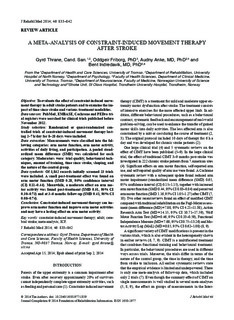| dc.contributor.author | Thrane, Gyrd | |
| dc.contributor.author | Friborg, Oddgeir | |
| dc.contributor.author | Anke, Audny | |
| dc.contributor.author | Indredavik, Bent | |
| dc.date.accessioned | 2019-11-07T10:57:25Z | |
| dc.date.available | 2019-11-07T10:57:25Z | |
| dc.date.created | 2014-09-06T20:59:33Z | |
| dc.date.issued | 2014 | |
| dc.identifier.citation | Journal of Rehabilitation Medicine. 2014, 46 (9), 833-842. | nb_NO |
| dc.identifier.issn | 1650-1977 | |
| dc.identifier.uri | http://hdl.handle.net/11250/2627159 | |
| dc.description.abstract | Objective: To evaluate the effect of constraint-induced movement therapy in adult stroke patients and to examine the impact of time since stroke and various treatment modalities.
Data sources: PubMed, EMBASE, Cochrane and PEDro trial registers were searched for clinical trials published before November 2012.
Study selection: Randomized or quasi-randomized controlled trials of constraint-induced movement therapy lasting 2–7 h/day for 8–28 days were included.
Data extraction: Measurements were classified into the following categories: arm motor function, arm motor activity, activities of daily living, and participation. A pooled standardized mean difference (SMD) was calculated for each category. Moderators were: trial quality, behavioural techniques, amount of training, time since stroke, shaping, and the nature of the control group.
Data synthesis: Of 3842 records initially screened 23 trials were included. A small post-treatment effect was found on arm motor function (SMD 0.28, 95% confidence interval (CI) 0.11–0.44). Meanwhile, a moderate effect on arm motor activity was found post-treatment (SMD 0.51, 95% CI 0.30–0.73) and at 3–6 months follow-up (SMD 0.41, 95% CI 0.08–0.74).
Conclusion: Constraint-induced movement therapy can improve arm motor function and improve arm motor activities and may have a lasting effect on arm motor activity | nb_NO |
| dc.language.iso | eng | nb_NO |
| dc.publisher | Foundation for Rehabilitation Information | nb_NO |
| dc.rights | Navngivelse-Ikkekommersiell 4.0 Internasjonal | * |
| dc.rights.uri | http://creativecommons.org/licenses/by-nc/4.0/deed.no | * |
| dc.title | A meta-analysis of constraint-induced movement therapy after stroke | nb_NO |
| dc.type | Journal article | nb_NO |
| dc.type | Peer reviewed | nb_NO |
| dc.description.version | publishedVersion | nb_NO |
| dc.source.pagenumber | 833-842 | nb_NO |
| dc.source.volume | 46 | nb_NO |
| dc.source.journal | Journal of Rehabilitation Medicine | nb_NO |
| dc.source.issue | 9 | nb_NO |
| dc.identifier.doi | 10.2340/16501977-1859 | |
| dc.identifier.cristin | 1152339 | |
| dc.description.localcode | © 2014 The Authors. Creative Commons Attribution Non-Commercial Licence 4.0 International | nb_NO |
| cristin.unitcode | 194,65,30,0 | |
| cristin.unitcode | 1920,15,0,0 | |
| cristin.unitname | Institutt for nevromedisin og bevegelsesvitenskap | |
| cristin.unitname | Medisinsk klinikk | |
| cristin.ispublished | true | |
| cristin.fulltext | original | |
| cristin.qualitycode | 1 | |

